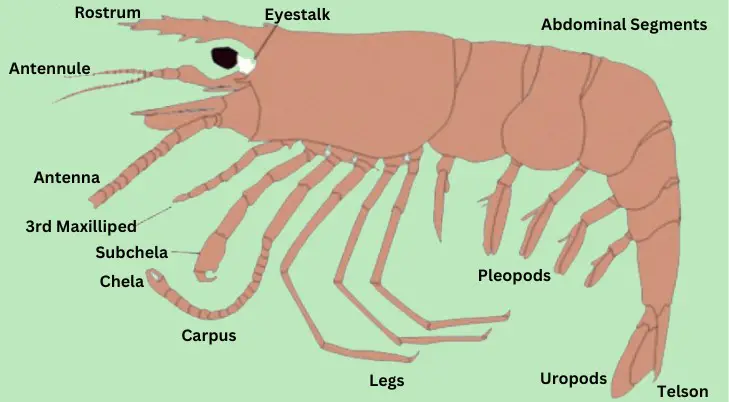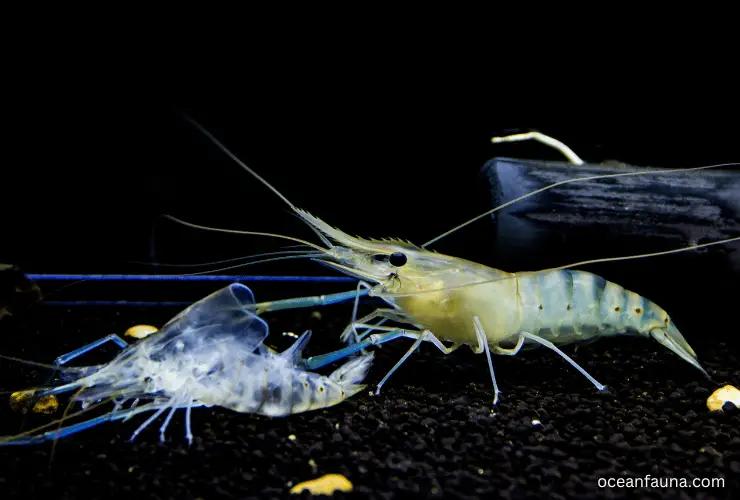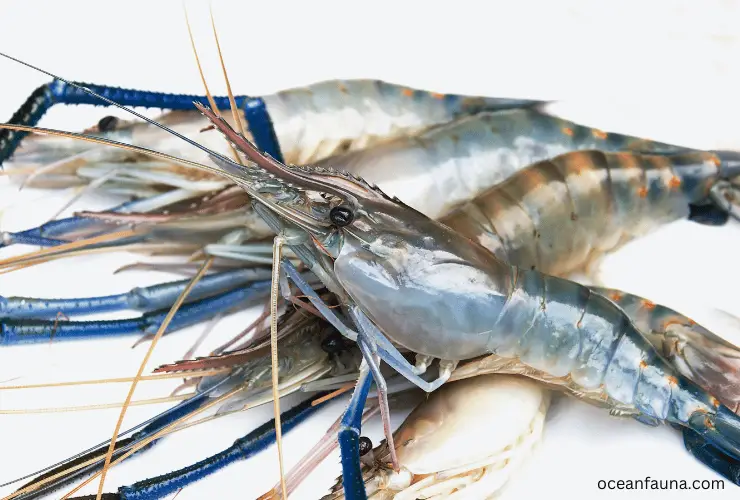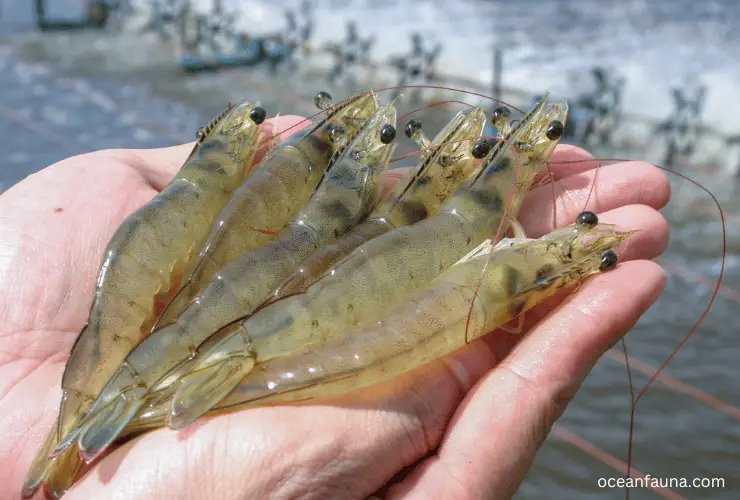Shrimp is undoubtedly a tasty food. But there are people out there who are more focused on the skeletal system of shrimp other than their taste. And they often ask do shrimp have bones?
No, shrimp have no bones in their body. Like humans or other fishes, shrimp have no bones in their internal body structures. However, they have a hard armor-like structure known as the exoskeleton. The exoskeleton provides support to its skeletal system and acts as a shield.
So if you’re enthusiastic about the skeletal system and anatomy of shrimp, you’re at the right place. This guide will cover your queries about whether shrimp have bones.
So without any further ado, let’s get started…
Understanding The Exoskeleton of Shrimp
Before we dive deep and discover whether shrimp have bones or not, I believe first, we need to understand the skeletal system and exoskeleton of shrimp.
The exoskeleton provides a number of functions for the shrimp. First and foremost, it protects the shrimp from predators and environmental hazards. It also provides support for the shrimp’s body, allowing it to move and swim through the water. Additionally, the exoskeleton serves as a site for muscle attachment, allowing the shrimp to move its limbs.

The cuticle is the outermost layer of the exoskeleton, and it is the thinnest and most flexible layer. It is composed primarily of lipids and proteins and provides a barrier against water loss and other environmental hazards.
The middle layer of the exoskeleton is made up of a substance called chitin. Chitin is a strong, flexible, and lightweight material that is found in the exoskeletons of many crustaceans, as well as in the wings of insects and the beaks of cephalopods. Chitin is a long-chain polymer that is composed of units of N-acetylglucosamine, a type of sugar.
The inner layer of the exoskeleton is composed primarily of protein. This layer
provides a site for muscle attachment, allowing the shrimp to move its limbs
and body. The protein in the exoskeleton is also responsible for the hardening process that occurs after molting.
Limitations of Exoskleleton
The exoskeleton does have some limitations. Unlike bones, which can grow and repair themselves, the exoskeleton of a shrimp cannot grow or repair itself. Instead, shrimp must periodically shed their exoskeleton in a process known as molting.
The old exoskeleton is shed during molting, and a new one is formed. This process leaves the shrimp vulnerable to predators and other dangers, as they are soft and unprotected while their new exoskeleton hardens.
This exoskeleton provides support, protection, and muscle attachment for the shrimp and plays an important role in their survival.
As you’ve read this far, I believe you’ve come across the term molting. So What is molting? And Why it’s Important?
Molting in Shrimp
Molting is a natural process that all crustaceans, including shrimp, go through to grow and develop. During this process, the shrimp will shed its exoskeleton and replace it with a new, larger one. In this article, we will explore the mechanics behind molting in shrimp.

Molting is a complex process triggered by hormonal changes in the shrimp’s body. These hormones signal the shrimp’s cells to stop producing the hard exoskeleton and to start secreting a new, softer one. The old exoskeleton then separates from the underlying tissue, and the shrimp begins to extract nutrients from the inner layers of the exoskeleton to build up the new one.
As the new exoskeleton begins to harden, the shrimp will begin to swell with
fluid, causing it to appear larger than normal. During this time, the shrimp is
very vulnerable to predators, as its soft and unprotected body is exposed. To
protect itself, the shrimp will often retreat to a safe location, such as a burrow or a hiding spot, until its new exoskeleton has fully hardened.
After the molt, the shrimp will be soft and vulnerable once again, and it will take several days for the new exoskeleton to fully harden. During this time, the shrimp will be less active and will avoid predators as much as possible.
Why is Molting Important?
Molting is a critical process for the growth and development of shrimp. By shedding their exoskeletons and replacing them with larger ones, shrimp can continue to grow and develop throughout their lifetimes.
In conclusion, molting is a fascinating and essential process in the life of a
shrimp. By shedding their old exoskeletons and replacing them with new ones, shrimp are able to continue to grow and develop throughout their lives.
However, this process also comes with risks and challenges. It requires careful management for shrimp to survive and thrive in their natural habitats.
Do Shrimp Have Bones?
So now let’s come to the main part, do shrimp have bones?

Shrimp is a type of small, aquatic crustacean that is popular seafood worldwide. They are enjoyed for their delicate flavor and texture and are often used in dishes like scampi, cocktails, and fried shrimp. However, many people have one question about shrimp: whether or not they have bones.
First, it’s important to understand that shrimp are part of a group of animals known as crustaceans. This group includes other animals like lobsters, crabs, and crayfish.
Like all crustaceans, shrimp have an exoskeleton, a hard outer shell that protects their body. This exoskeleton is made up of a substance called chitin. This is similar to the material that makes up insect exoskeletons.
Unlike humans and other vertebrates, shrimp do not have bones in the traditional sense. Instead, their exoskeleton serves as their skeletal
structure. The exoskeleton is made up of several layers, including an outer layer of cuticle, a middle layer of chitin, and an inner layer of protein.
So while shrimp do not have bones in the traditional sense, they do have a complex and well-developed exoskeleton that serves as their skeletal structure.
How do Shrimp Move and Swim?
As you already know, shrimp don’t have bones like humans. Instead, they have a different and unique skeletal system.
So, despite having no bones, how do shrimp move and swim? Well, if you’re also thinking the same, this part is for you!

Shrimp are known for their swift and agile movements in the water. Their ability to move and swim is made possible by combining their unique anatomy and behavior.
Shrimp have a streamlined body shape that is ideal for moving efficiently through the water. Their bodies are divided into two central regions: the cephalothorax and the abdomen.
Uses Muscle Contractions To Move and Swim
Shrimp move by using a series of rapid and coordinated muscle contractions. These muscle contractions cause the shrimp to flex and extend its abdomen, which propels it forward through the water.
The tail is the main driving force for movement, as it is more flexible and contains more muscle than the rest of the body.
The movement of the tail is controlled by the telson, which is the center part of the tail. The telson contains a pair of swimmerets, which are small appendages that help to control the direction and speed of the shrimp’s movement.
Uses Their Legs To Move and Swim
In addition to the tail, the shrimp also uses its legs to move and swim. The shrimp has five pairs of legs, with the first three being the most important for swimming. These legs are long and thin and covered in small hairs called setae.
The setae help increase the legs’ surface area, allowing the shrimp to swim more efficiently through the water.
The legs of the shrimp also play an important role in turning and maneuvering. By rapidly moving their legs back and forth, shrimp can change direction quickly and avoid obstacles in their path. They can also use their legs to anchor themselves to the substrate and stay in one place when necessary.

Overall, shrimp’s unique anatomy and behavior allow them to move and swim with remarkable speed and agility. Their streamlined body shape, powerful tail, and flexible legs work together to help them navigate their aquatic environment.
Understanding how shrimp move and swim can help us appreciate the fascinating adaptations these creatures have developed to survive in their natural habitat.
FAQ
Does lobster have bones?
Ans: Lobsters, like other crustaceans, do not have bones like humans and other vertebrates do. Instead, their bodies are protected by a hard exoskeleton made of chitin, a tough, fibrous material that provides a rigid outer layer. A lobster’s exoskeleton comprises several sections, including the head, thorax, and abdomen.
Does seafood have bones?
Ans: It depends on the type of seafood. Some types of seafood, such as fish, have bones, while others, such as shrimp, do not.
Is shrimp a fish or not?
Ans: No, shrimp is not a fish. Shrimp is a type of crustacean, a large group of aquatic arthropods that also includes crabs, lobsters, and crayfish. While fish are vertebrates that belong to the class Actinopterygii, shrimp, and other crustaceans are invertebrates that belong to the phylum Arthropoda.
Conclusion
In conclusion, shrimp do not have bones in the traditional sense. Still, they do have a hard exoskeleton made of chitin that provides support and protection for their bodies. This exoskeleton is periodically shed and replaced through a process known as molting.
Understanding the anatomy and biology of shrimp is important for chefs and home cooks and conservation efforts to ensure the sustainability of shrimp populations.
By learning more about these fascinating creatures, we can appreciate their unique characteristics and work towards protecting their habitats and ecosystems for future generations to enjoy.
So do shrimp have bones? I believe you already have got your answer. So next time someone asks this, I bet you can enlighten him or her about this amazing fact about shrimp.
That’s all. We’ll be back with some more amazing facts. And thank you for reading till the end.

